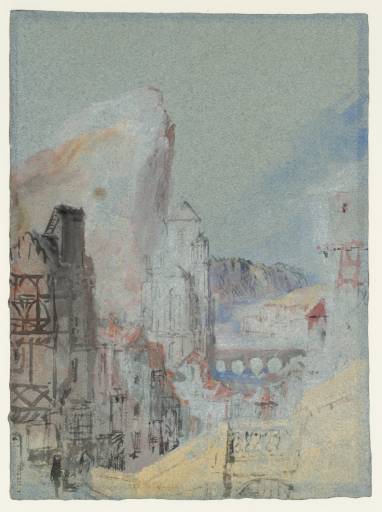Joseph Mallord William Turner Notre-Dame, Huy c.1839
Joseph Mallord William Turner,
Notre-Dame, Huy
c.1839
Joseph Mallord William Turner 1775–1851
Notre-Dame, Huy c.1839
D20268
Turner Bequest CCXXII I
Turner Bequest CCXXII I
Gouache, pen and ink and watercolour on blue wove paper, 188 x 139 mm
Blind-stamped with Turner Bequest monogram bottom right
Stamped in black ‘CCXXII I’ bottom left ascending
Blind-stamped with Turner Bequest monogram bottom right
Stamped in black ‘CCXXII I’ bottom left ascending
Accepted by the nation as part of the Turner Bequest 1856
Exhibition history
1896
Fifth Loan Collection, National Gallery, London, 1896, Grosvenor Museum, Chester, 1897–9, Corporation Galleries, Glasgow, 1900–2, National Gallery, London, 1903, Museum and Art Gallery, Bristol, 1904–6, National Gallery, London, 1907–8, Liverpool Art Gallery, 1909–10, Aberdeen, 1911, Nottingham Art Gallery, 1912, Grosvenor Museum, Chester, 1913, Museum and Art Gallery, Plymouth, February 1914, Blackpool, 1915, Blackburn Art Gallery, 1916–18, Bradford Art Gallery, 1919–20, Burnley, 1921–2, Colne, 1923–4, Rawtenstall, 1925–6, Tate Gallery, London, 1927–30, transferred to the British Museum, London 1931 (no catalogue but numbered 22).
1933
Victoria and Albert Museum Circulation Department, London, September 1933 (no catalogue, but numbered 22).
1971
Victoria and Albert Museum Circulation Department Conservation Studio, London, ?1971 (no catalogue).
1991
Turner’s Rivers of Europe: The Rhine, Meuse and Mosel, Tate Gallery, London, September 1991–January 1992, Musée Communal d’Ixelles, Brussels, February–April 1992 (86, reproduced).
2001
La Meuse, de Turner à Delvaux, Maison de la Culture, Namur, September–October 2001 (64, reproduced in colour, p.[25]).
References
1909
A.J. Finberg, A Complete Inventory of the Drawings of the Turner Bequest, London 1909, vol.II, p.690, as ‘Town (Rhine or Moselle ?) with lofty crag’.
1991
Cecilia Powell, Turner’s Rivers of Europe: The Rhine, Meuse and Mosel, exhibition catalogue, Tate Gallery, London 1991, p.153 no.86 reproduced.
In this drawing Turner depicts the Walloon city of Huy with its Collegiate Church of Notre-Dame to the left of the bridge. Traditional half-timbered buildings line a narrow street in the foreground, while a giant precipice looms vertiginous in the background.
Turner referred to a rough pencil jotting of Notre-Dame in the Spa, Dinant, and Namur sketchbook to represent the church’s apse and towers here (Tate D28147; Turner Bequest CCLXXXVII 56a). This pencil sketch was taken from a high vantage point to the south-east of Huy at the Place Saint-Denis, captured while on an excursion on foot which took the artist inland and into the foothills of the city, away from the Meuse itself.
Much of what is represented in this gouache, however, is the product of Turner’s imagination. That is to say the artist has removed and rearranged landmarks to suit his composition. As Cecilia Powell notes, it would have been impossible for Turner to see up the Meuse from this viewpoint, though this did not deter him from depicting the bridge and the river in the middle distance, marking out the latter with daubs of blue gouache.1 The most ‘fanciful’ aspect of the gouache is, Powell writes, the total elimination from the composition of the formidable citadel of Huy which dominates the city from a vertiginous promontory above Notre-Dame.2 Powell proposes that Turner’s omission of this conspicuous symbol of military power amounts to a deliberate re-portrayal of Huy as ‘a picturesque old town, free from external threats’.3
In fact, owing to its strategic location, the citadel must have invited significant political and military upheaval for the people of Huy. In this much-contested region, the fortress became the dominion of whichever European power had control of Walloon at the time. Huy and its citadel had been under French rule, for example, during parts of the reign of Louis XIV. The Dutch, on the other hand, gained this territory and rebuilt Huy’s citadel into a mighty artillery barracks. 4 The citadel, then, could easily have stood as a symbol of the protracted episodes of war in which the Low Countries were embroiled.
By the time of Turner’s visit in 1839, however, Belgium was enjoying ‘the advent of real peace’ and Huy, ‘an era of tranquillity’.5 Turner conveys the impression of societal harmony in this drawing most significantly through his removal of the citadel but also through his employment of a rather muted palette of pale blue, apricot, lemon yellow and light terracotta pigments.
Verso:
Stamped with Turner Bequest monogram and ‘CCXXII I’ at bottom right.
Alice Rylance-Watson
June 2013
How to cite
Alice Rylance-Watson, ‘Notre-Dame, Huy c.1839 by Joseph Mallord William Turner’, catalogue entry, June 2013, in David Blayney Brown (ed.), J.M.W. Turner: Sketchbooks, Drawings and Watercolours, Tate Research Publication, November 2014, https://www

